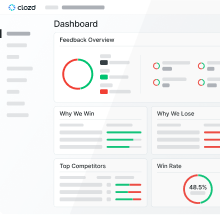Why does your company win and lose deals?
Can you confidently answer that question? Now, think about your executive team. Would each functional head give a similar response? Is there clarity and consensus org-wide?
Now, what would happen if you could get everyone on the same page? The answer is that performance would improve and everyone’s job would be easier. Why? Because when there's clarity and consensus about how and why you win and lose, you can focus resources on building, marketing, selling, and delivering against those key factors.
Formal win-loss analysis can deliver a clear understanding of the common factors that drive wins and losses. If you aren't sure what constitutes an effective win-loss program, start here.
Not only will win-loss analysis drive alignment across the org, but it will provide critical insights and direction for practically every function:
Executive Team
• Get the complete, unbiased story behind key wins and losses.
• Minimize bias and internal politics by focusing on feedback from actual buyers.
• Align strategic efforts around investments that really will drive more wins.
• Confirm and weight the anecdotes that circulate internally about key wins and losses.
Marketing
• Discover how buyers perceive your company and your product offering.
• Build buyer personas based on actual people and real stories, not theoretical exercises.
• Uncover gaps in your content and messaging.
• Keep a pulse on the evolution and messaging of your top competitors.
Sales
• Base training and coaching sessions on actual feedback from decision-makers.
• Uncover the recipe for why and how you win, so more reps can replicate the successes.
• Discover your competitive advantages to exploit against each key competitor.
• Discover competitive disadvantages and traps to avoid or address during the sales cycle.
Product
• Develop your roadmap based on the unbiased feedback of actual buyers.
• Refine your product roadmap based on product gaps that really do impact sales.
• Gain a clearer understanding of your product’s relative strengths and weaknesses.
• Keep a pulse on the innovation of top competitors, from the perspective of actual buyers.
Corporate Development & Finance
• Understand your competitive landscape so you can make more informed investments.
• Identify new players in your space and potential acquisition targets.
Implementation & Client Success
• Learn what decision drivers matter most during the sales cycle, so you can deliver solutions.
• Uncover the root causes of churn, so you can avoid the same pitfalls in the future.
• Discover how to properly set expectations to ensure satisfaction and renewal.
• Find out which external factors drive upgrades and look for them with other clients.
One challenge to gaining these benefits is clearly defining what a good program looks like. Here are some things to keep in mind if you are running or thinking about running a win-loss program:
- Program, Not Project - often times companies will indulge in post-mortem or other one off efforts to try to understand why they win and lose. These efforts tend to yield little results. Companies that get the most out of win-loss systematically engage with buyers in an on-going basis to have an up-to-date pulse on what is happening on the front line.
- Go Straight to the Decision Maker - If you want to know what really is going on with your most critical deals, you need to talk directly to the buyer. This will give you the direct story instead of playing the schoolyard game of telephone through the sales team.
- Use Interviews, not Surveys or CRM Drop-Downs - Most companies try to tackle this through the dreaded CRM drop down. Sales reps rush through these fields. The data is inaccurate. Another option is the quick survey. While surveys can be effective, remember that decision makers tend to not participate (they don’t have time) and if they do, they won’t spend more than 3 minutes. CRM fields and surveys can get you 6 inches deep into a 10 foot deep pool.
- Leverage a Neutral, Third-Party - Buyers will be more candid with a third party. Moreover, the findings will not be viewed as biased by any department and will be more easily ingested into your org.
- Share the Findings Broadly - Make sure the third party is able to deliver the findings in a shareable format and leverages technology so that you can get your entire org up to speed on what is happening.
If you want to learn more about best practices in the win-loss space, check out the Clozd Learning Center or our Definitive Guide to Win-Loss Analysis.











.svg)











.svg)

.svg)




